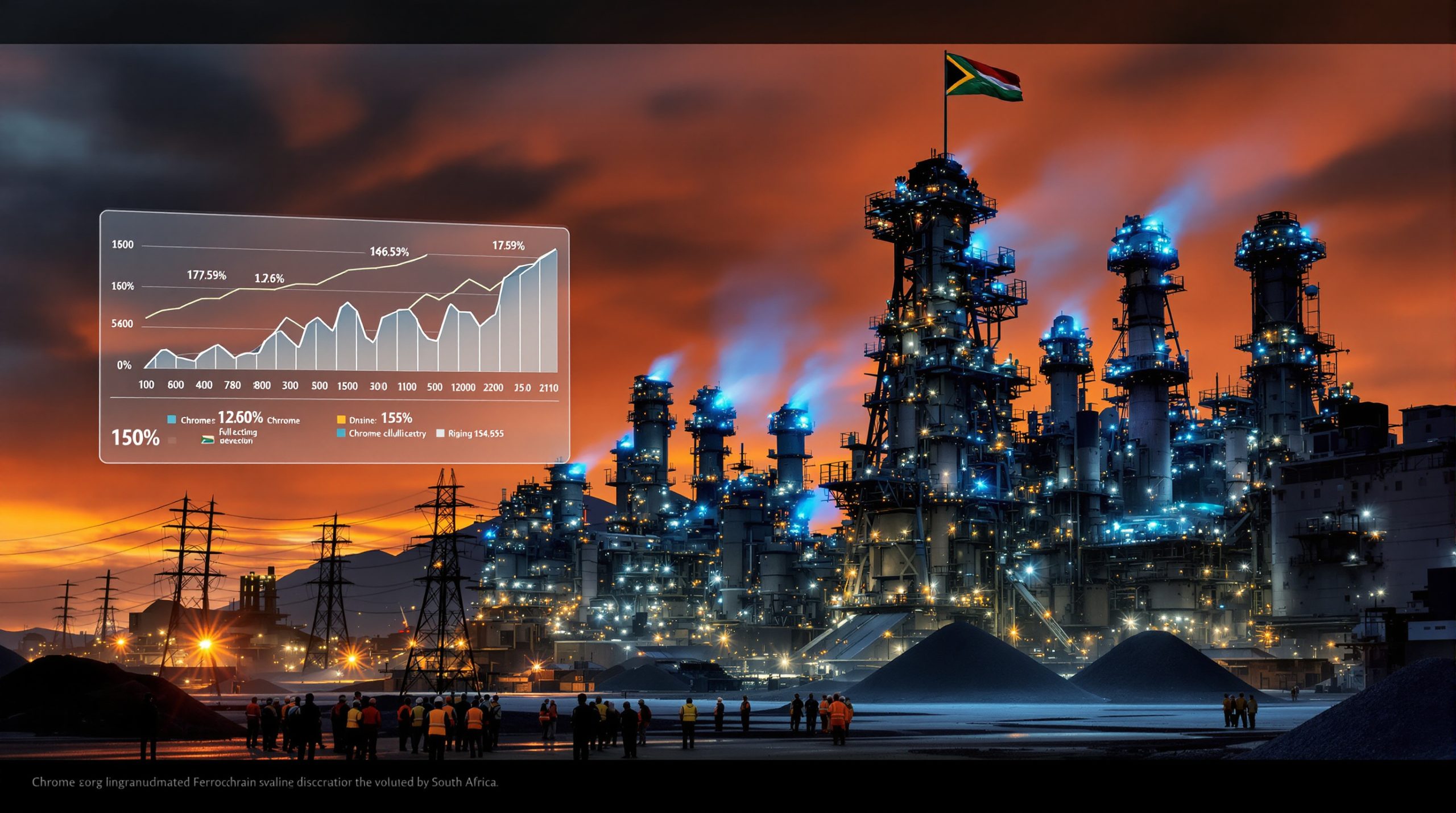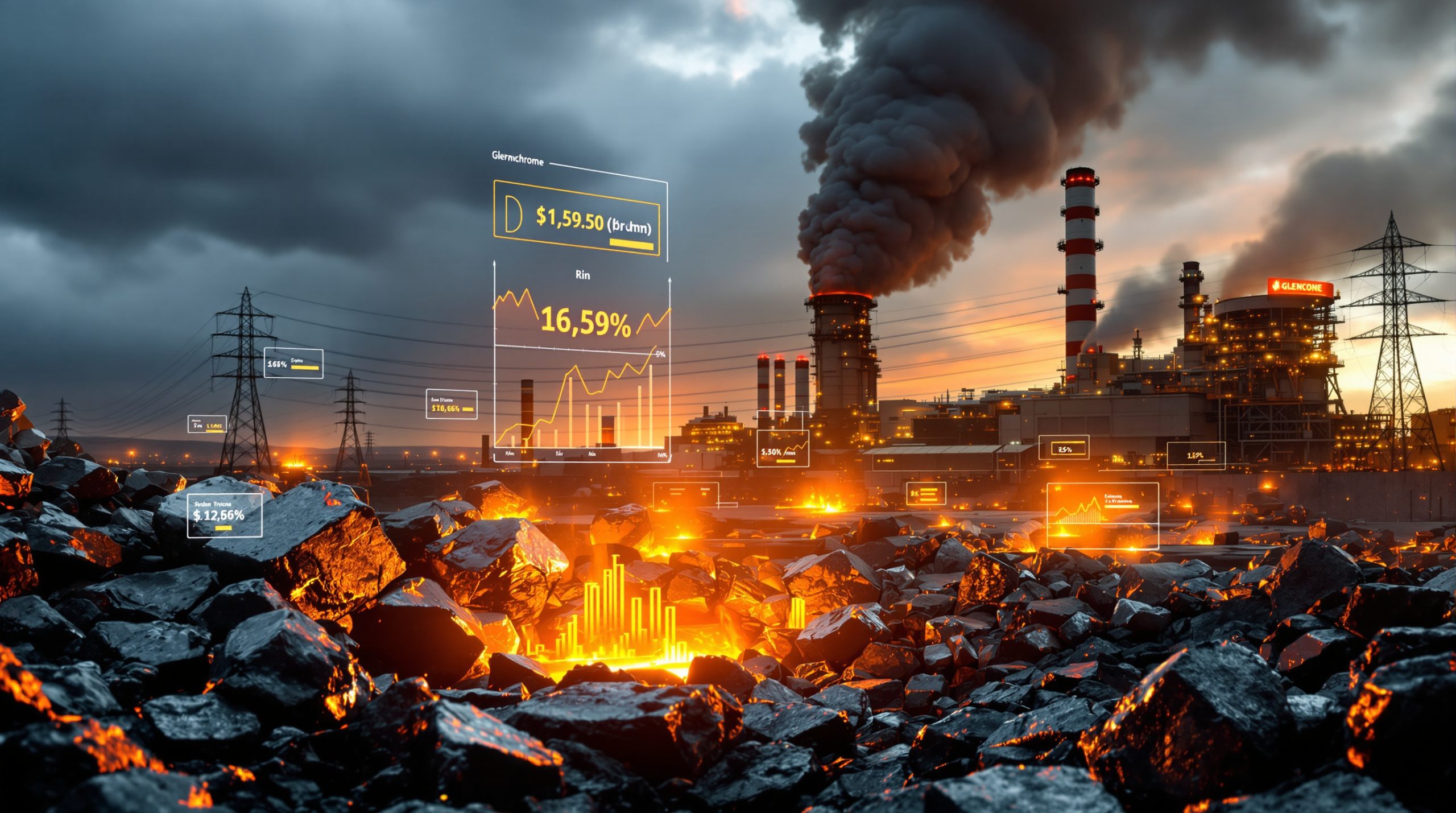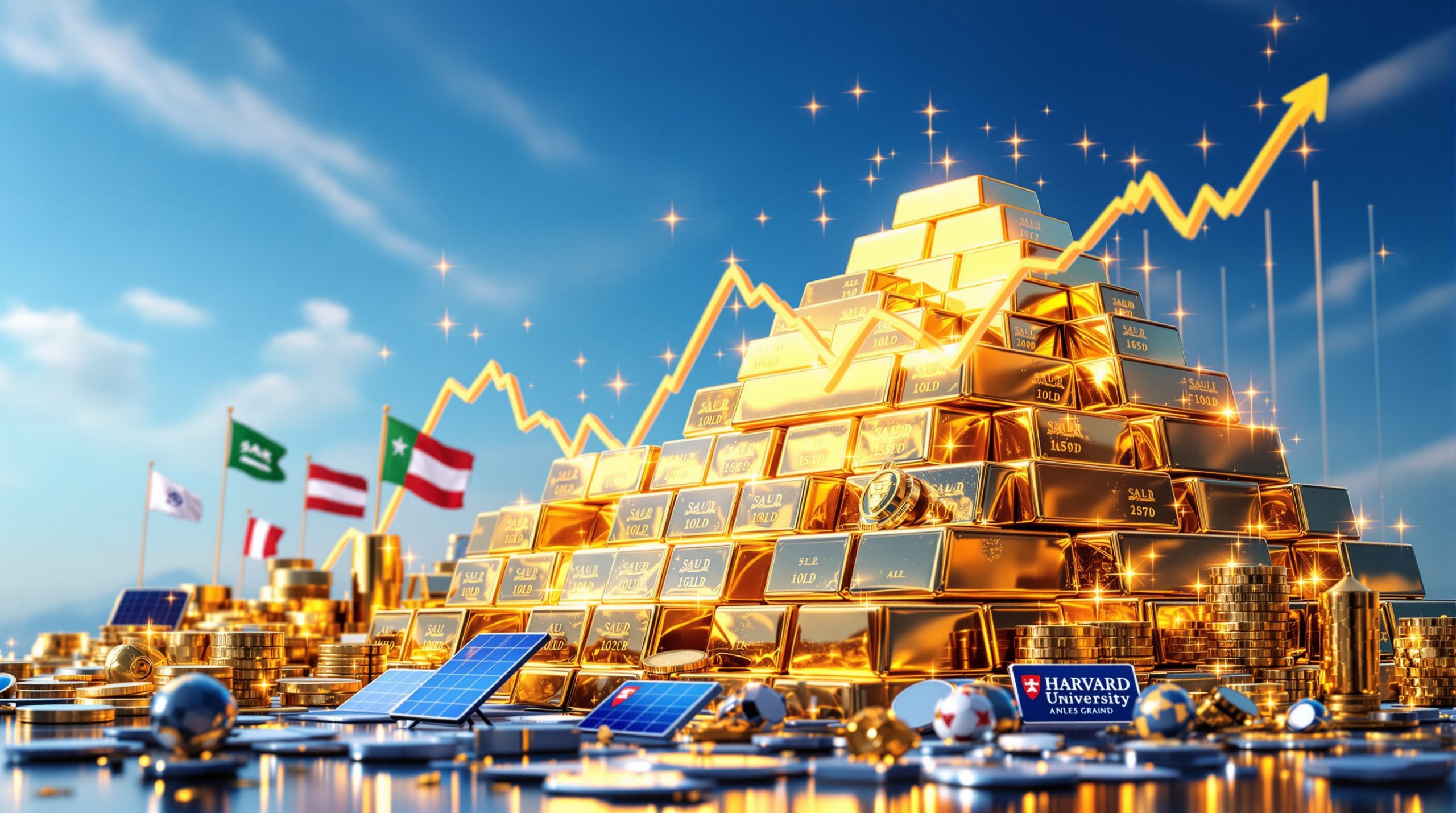China's Gallium Dominance Explained: Strategic Importance and Western Responses
In today's high-tech world, a little-known metal called gallium has emerged as a focal point in the growing technological competition between China and Western nations. Despite its obscurity, gallium's importance to modern electronics, defense systems, and green technologies has transformed it from a metallurgical curiosity into a geopolitical chess piece.
What is Gallium and Why Does it Matter?
Gallium represents a fascinating paradox in the critical minerals landscape—a metal with a relatively tiny market size but enormous strategic significance. According to the latest USGS data, global production in 2024 reached only 760 metric tons, with an estimated market value of approximately $550 million globally.
Despite these modest numbers, gallium serves as an essential component in technologies that underpin modern economies and defense systems. The disconnect between gallium's small production volume and its outsized importance makes it a perfect case study in how seemingly minor materials can become central to global strategic competition.
The Strategic Importance of an Obscure Metal
Gallium is a soft, silvery metal that melts at just 29.8°C (85.6°F), meaning it can literally melt in your hand. This unusual property, combined with its excellent semiconductor characteristics, makes gallium irreplaceable in numerous applications that define our technological age.
The metal rarely exists in concentrated form in nature; instead, it appears as trace elements in bauxite ore (aluminum's source) and zinc ores. This dispersed distribution means gallium is almost exclusively produced as a byproduct of aluminum processing—creating a direct link between aluminum production capacity and gallium supply potential.
As one industry analyst noted, "Gallium is the perfect example of how even the smallest markets can have the largest strategic implications." This reality has become increasingly apparent as China has leveraged its aluminum industry dominance to establish near-complete control over global gallium supply.
Key Applications Driving Gallium's Strategic Value
Gallium's importance stems primarily from its role in compound semiconductors—particularly gallium arsenide (GaAs) and gallium nitride (GaN). These compounds deliver performance characteristics that silicon-based semiconductors cannot match in specific applications:
- Advanced Radar Systems: GaN-based radar can track smaller, faster targets from nearly twice the distance of conventional systems
- 5G Telecommunications: GaAs powers the radio frequency components essential for high-speed wireless networks
- LED Lighting: Gallium nitride enables efficient blue LEDs that revolutionized lighting technology
- Electric Vehicle Power Systems: GaN transistors improve power conversion efficiency
- Solar Cells: Gallium arsenide provides the highest efficiency photovoltaic cells available
- Military Guidance Systems: Precision-guided weapons rely on gallium-based semiconductors
According to the Center for Strategic and International Studies (CSIS), "Gallium nitride is revolutionizing modern radar, allowing new radar modules to track smaller, faster, and more numerous threats from nearly double the distance." This capability makes gallium indispensable for modern defense systems, including those used in the F-35 Joint Strike Fighter and Patriot missile defense systems.
How Did China Achieve Dominance in Gallium Production?
China's control of approximately 94% of global gallium production didn't happen by accident. It represents the culmination of decades of strategic planning, industrial policy, and market manipulation that has systematically eliminated Western competition.
China's Strategic Mineral Monopoly
China's gallium dominance grew alongside its massive aluminum industry expansion. As the world's largest aluminum producer (generating approximately 60% of global output), China gained unmatched access to the bauxite processing streams from which gallium is extracted.
This gave Chinese producers an inherent advantage, which they leveraged through aggressive market tactics. As Andy Home of Reuters noted, "China flooded the market at the start of the last decade, forcing Western producers to abandon operations." This deliberate price suppression created a manufacturing vacuum that Chinese companies quickly filled.
By 2015, Western gallium production had effectively ceased, leaving China as the unchallenged supplier to global markets. This position was further solidified when the Chinese government formally designated gallium as a strategic mineral, integrating it into national industrial planning.
Export Restrictions as Economic Leverage
China's dominant position remained relatively uncontroversial until August 2023, when Beijing implemented export controls on gallium and germanium. This move came as a direct response to US semiconductor restrictions targeting Chinese companies.
The export controls created an immediate dual pricing system—lower prices for domestic Chinese manufacturers and significantly higher prices for international buyers. More pointedly, China specifically banned direct sales to American companies, creating supply chain complications for US defense and technology sectors.
The impact was immediate and severe. Gallium prices surged from approximately $350/kg in July 2023 to more than $725/kg by early 2025, with the price differential between Chinese domestic and international markets continuing to widen.
This price manipulation demonstrates how China can use its critical minerals energy security as a "pressure point" in broader technological competition with Western nations. As one industry observer noted, "The gallium export restrictions serve as a warning shot, demonstrating China's willingness to weaponize its control of critical minerals."
What Are the Economic Impacts of China's Gallium Control?
The ripple effects of China's gallium export restrictions extend far beyond the relatively modest size of the gallium market itself, creating multiplier effects that impact major industries and national economies.
The Multiplier Effect on Western Economies
According to USGS estimates, a one-year suspension of Chinese gallium exports would cost the US economy approximately $3.1 billion—nearly six times the size of the entire global gallium market.
This outsized impact occurs because gallium sits at the beginning of complex, high-value supply chains. The economic impact distributes across industries in a revealing pattern:
- Semiconductor Industry: Approximately 50% of the economic impact ($1.55 billion)
- Downstream Electronics: 25% impact on printed circuit assembly and computer manufacturing
- Telecommunications Equipment: 15% of total economic impact
- Electric Vehicle Production: 10% of impact, primarily in power systems
As advanced GaN semiconductors become more essential to emerging technologies, these multiplier effects will likely increase. The economic vulnerabilities exposed by gallium restrictions have prompted urgent reassessment of critical raw materials facility development across Western economies.
Price Volatility and Supply Chain Disruptions
Beyond direct cost increases, the unpredictability created by export restrictions has disrupted long-term contracts and created supply uncertainty. Companies accustomed to stable supply arrangements suddenly found themselves scrambling for alternative sources or paying premium prices through intermediaries.
Chinese authorities have further complicated matters by blocking price arbitrage opportunities. The Ministry of Commerce implemented regulations preventing Chinese companies from exporting to third countries that might then re-export to restricted markets like the United States.
This supply chain reconfiguration adds significant costs beyond the gallium price increases themselves. Companies must devote resources to supply chain redesign, alternative sourcing strategies, and in some cases, product redesign to reduce gallium dependence.
Why is Gallium Critical for National Security?
The strategic importance of gallium extends well beyond commercial applications, with particularly vital implications for modern defense systems. The metal's role in military technology helps explain why export restrictions triggered such serious concern among Western defense planners.
Military Applications and Defense Implications
The US Defense Advanced Research Projects Agency (DARPA) pioneered the development of gallium arsenide compounds for military applications decades ago. This early investment reflected DARPA's recognition that gallium-based semiconductors offered performance characteristics essential for advanced defense systems.
Today, gallium nitride semiconductors form the foundation of modern radar capabilities. According to defense analysts, GaN-based radar systems can detect smaller objects at greater distances while using less power than conventional systems. This capability proves critical for identifying and tracking advanced threats, including hypersonic missiles and stealth aircraft.
The Lower-Tier Air and Missile Defense Sensor (LTAMDS) system, which undergirds Patriot missile defense, relies heavily on gallium nitride technology. Similarly, the F-35 Joint Strike Fighter's advanced radar systems leverage gallium compounds for superior performance.
Military officials acknowledge that numerous classified applications likely exist in next-generation defense systems that cannot be publicly disclosed. This reality only amplifies concerns about supply chain vulnerability for such a strategically significant material.
The Technology Competition Dimension
Gallium and China's minerals dominance represents perhaps the most perfect intersection of economic and national security concerns in the critical minerals space. Control of seemingly obscure materials translates directly into leverage in broader technological competition between major powers.
China's export restrictions specifically target areas where Western nations maintain technological advantages, particularly in advanced defense systems. By controlling a critical input to these systems, China gains influence over the pace of Western technological development.
This dynamic demonstrates how even small-volume minerals can have outsized strategic importance when they serve as irreplaceable components in advanced technologies. As one defense analyst observed, "You can't build a fifth-generation fighter jet without certain critical minerals, regardless of how much money you throw at the problem."
How Can Western Nations Break China's Gallium Monopoly?
Facing both economic and security pressures from China's gallium dominance, Western nations have begun urgent efforts to develop alternative supply sources. Early progress suggests that China's monopoly may prove less insurmountable than initially feared.
Rediscovering Domestic Production Capabilities
The gallium supply challenge has a unique characteristic: the mineral exists within waste streams of Western aluminum production but has simply been ignored. This oversight creates potential opportunities for relatively rapid supply diversification.
Western companies previously produced gallium but abandoned production when Chinese suppliers flooded the market with below-cost material. This history means that basic technical knowledge exists, though it requires updating and scaling.
Recent developments show promise. Rio Tinto and Indium Corporation announced successful extraction of high-purity gallium from the Vaudreuil alumina refinery in Quebec, Canada. Their pilot plant, with 3.5 tons annual capacity, demonstrates that Western companies can produce gallium from existing operations.
More ambitious is Greek aluminum producer METLEN's plan to establish gallium production capacity of 50 tons annually by 2028—representing approximately 6.5% of current global production. If successful, this single facility would significantly reduce Western dependence on Chinese supplies for critical applications.
Broader Strategies for Critical Minerals Independence
The gallium case has prompted broader reassessment of waste streams from existing metal processing operations. Companies are discovering that many critical minerals already exist within their waste materials but were previously ignored due to low prices and lack of strategic awareness.
Rio Tinto provides compelling examples of this approach, successfully extracting scandium from titanium operations and tellurium from copper smelting waste streams. These projects demonstrate that Western operators can recover multiple critical minerals from existing operations with targeted investments in processing technology.
The European Union has designated 47 strategic minerals projects, including gallium production initiatives, under its Critical Raw Materials Act. This coordination between government policy and private investment creates a more favorable environment for developing alternative supply sources.
Higher prices resulting from Chinese export controls have created economic incentives for Western companies to develop extraction capabilities that previously seemed uneconomical. As one industry executive noted, "The price signal finally makes it worthwhile to implement recovery processes that have been technically possible but economically unattractive."
What Are the Challenges in Developing Alternative Supply Chains?
Despite promising developments, Western efforts to establish alternative gallium supply chains face significant obstacles. These challenges combine technical, economic, and policy dimensions that require coordinated approaches.
Technical and Economic Hurdles
China's dominance extends beyond the mineral itself to the processing technologies used to extract and purify gallium. Chinese authorities have restricted exports of these technologies alongside the minerals themselves, complicating Western efforts to rebuild production capacity.
Western companies must effectively redevelop metallurgical expertise that atrophied during decades of Chinese market dominance. As East Asia Forum explains, "Western operators are having to re-learn processing technologies abandoned decades ago." This knowledge gap creates delays and increases development costs.
Initial production costs for Western gallium operations will likely exceed established Chinese facilities due to higher labor costs, environmental standards, and the learning curve associated with reestablishing production. Without long-term commitments from purchasers, companies may hesitate to make the necessary capital investments.
Perhaps most concerning is the possibility that once Western production capacity develops, China could again flood markets with below-cost gallium to eliminate competition. This threat of predatory pricing creates investment uncertainty that only government policy can effectively address.
Policy and Investment Requirements
Developing resilient gallium supply chains requires coordinated government support beyond what market forces alone can provide. Strategic stockpiling programs represent one approach, providing guaranteed purchases that can justify private sector investments in production capacity.
Research funding for alternative extraction technologies can accelerate development timelines and potentially create more cost-effective production methods. Similarly, investment incentives like tax credits or fast-track permitting can help offset the economic risks of establishing new production facilities.
Trade policy alignment among Western allies creates more predictable market conditions for new producers. By coordinating approaches to critical minerals across friendly nations, governments can create larger markets that support diverse supply sources.
In the context of the ongoing US-China trade war, one policy analyst noted, "Critical minerals security requires treating these materials as strategic assets rather than purely commercial commodities." This perspective shift necessitates new approaches that balance market principles with national security requirements.
What Lessons Does Gallium Teach About Critical Minerals Strategy?
The gallium case study offers broader insights for critical minerals policy, highlighting both vulnerabilities and opportunities that extend across numerous strategic materials.
Hidden Resources in Existing Operations
Perhaps the most important lesson from gallium is that many critical minerals already exist within Western industrial operations but remain unrecovered. This oversight has inadvertently strengthened China's position while leaving valuable resources literally in waste piles.
Comprehensive auditing of existing mining and metallurgical operations can identify opportunities to extract critical minerals from waste streams or byproducts. As processing technologies advance, materials previously considered uneconomical may become viable resources.
The economic calculus for byproduct recovery changes dramatically when strategic importance and supply security enter the equation. Materials that might not justify recovery based solely on market price may become essential investments when their role in defense systems or crucial technologies is considered.
The Relearning Curve for Western Industry
Western deindustrialization created knowledge gaps that now pose significant challenges for critical minerals independence. Rebuilding metallurgical expertise requires time, investment, and institutional commitment that crosses both public and private sectors.
Technology transfer restrictions from China create additional hurdles for Western producers seeking to reestablish capacity. Companies must invest in research and development to create alternative processing methods rather than simply licensing existing technologies.
The higher prices resulting from Chinese export controls provide economic incentives for this innovation process. Public-private partnerships can accelerate capability development by combining government research funding with private sector commercialization expertise.
Long-term strategic planning proves essential to prevent future dependencies from developing. As critical minerals become increasingly important to emerging technologies, identifying potential supply vulnerabilities before they become critical shortages represents a key policy challenge for Western nations implementing a critical minerals pivot and a new critical minerals executive order.
FAQs About Gallium and Critical Minerals
What makes gallium a "critical mineral"?
Gallium qualifies as a critical mineral due to four key factors: its essential role in advanced technologies, limited substitutability in key applications, concentrated supply chain dominated by a single country (China), and its importance to national security applications, particularly in defense systems. Unlike some bulk commodities, gallium's criticality stems more from its strategic applications than its absolute market size.
How is gallium extracted and processed?
Gallium is primarily extracted as a byproduct from bauxite processing during aluminum production. It exists in trace amounts (typically 50 parts per million) in bauxite ore and can be separated during the alumina refining process. The metal requires specialized metallurgical techniques to isolate and purify to semiconductor-grade quality, with multiple refining steps needed to achieve 99.99999% purity required for electronic applications.
Could recycling help address gallium supply concerns?
While recycling could theoretically help, gallium's use in minute quantities in most applications makes recovery economically challenging. The metal is typically dispersed throughout devices in concentrations too low for cost-effective extraction. However, targeted recycling of gallium-rich components from military and specialized electronic applications could supplement primary production. Current recycling rates remain below 1% of annual consumption.
What other critical minerals face similar supply chain vulnerabilities?
Similar supply chain vulnerabilities exist for rare earth elements (particularly heavy rare earths), cobalt, germanium, graphite, and lithium, where China maintains dominant positions. Each presents unique challenges, but the strategic approach to diversifying supply chains follows similar principles. The USGS Critical Minerals List (updated 2024) identifies 50 minerals with supply chain vulnerabilities that could impact national security or economic wellbeing.
How long would it take Western nations to develop significant gallium production?
Based on current projects, Western nations could develop meaningful gallium production within 3-5 years. Rio Tinto's pilot plant and METLEN's larger facility represent the first steps, but scaling to meet significant portions of global demand would likely take 5-7 years of sustained investment. The technical knowledge exists, but rebuilding production capacity requires both capital investment and reestablishing metallurgical expertise that has atrophied during decades
Ready to Spot the Next Major Mineral Discovery?
Discovery Alert's proprietary Discovery IQ model provides instant, real-time alerts on significant ASX mineral discoveries, giving you the edge to capitalise on opportunities before the broader market. Visit our discoveries page to see how major mineral discoveries have generated substantial returns for early investors.




